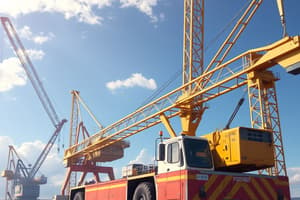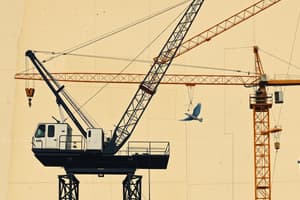Podcast
Questions and Answers
The ASME B30.2-2022 Standard is scheduled for publication in 2025.
The ASME B30.2-2022 Standard is scheduled for publication in 2025.
False (B)
The ASME B30.2-2022 Standard will become effective 2 years after the Date of Issuance.
The ASME B30.2-2022 Standard will become effective 2 years after the Date of Issuance.
False (B)
ASME issues written replies to inquiries concerning technical aspects of this Standard.
ASME issues written replies to inquiries concerning technical aspects of this Standard.
True (A)
Errata to codes and standards may be posted on the ASME website under the Committee Pages to provide corrections to incorrectly published items.
Errata to codes and standards may be posted on the ASME website under the Committee Pages to provide corrections to incorrectly published items.
The ASME website does not provide an option to automatically receive an e-mail notification when errata are posted to a particular code or standard.
The ASME website does not provide an option to automatically receive an e-mail notification when errata are posted to a particular code or standard.
The Date of Issuance of the ASME B30.2-2022 Standard is August 24, 2025.
The Date of Issuance of the ASME B30.2-2022 Standard is August 24, 2025.
The provisions in Volume B3 0.2 apply to the construction of cranes used for lifting personnel.
The provisions in Volume B3 0.2 apply to the construction of cranes used for lifting personnel.
Cantilever gantry cranes are not included in the requirements of Volume B3 0.2.
Cantilever gantry cranes are not included in the requirements of Volume B3 0.2.
Dynamic braking involves reversing the motor line voltage polarity or phase sequence.
Dynamic braking involves reversing the motor line voltage polarity or phase sequence.
Eddy current braking is a method of controlling or reducing speed by means of an electrical induction load brake.
Eddy current braking is a method of controlling or reducing speed by means of an electrical induction load brake.
Emergency braking is used to slow down a crane when the operator desires to do so.
Emergency braking is used to slow down a crane when the operator desires to do so.
Top-running single girder or multiple girder bridge cranes with one or more toprunning trolley hoists are excluded from the requirements of Volume B3 0.2.
Top-running single girder or multiple girder bridge cranes with one or more toprunning trolley hoists are excluded from the requirements of Volume B3 0.2.
ANSI Z535.4 governs the marking of crane controllers.
ANSI Z535.4 governs the marking of crane controllers.
Only floor-operated cranes require safety labels.
Only floor-operated cranes require safety labels.
A single wind speed indicating device can serve multiple cranes indoors.
A single wind speed indicating device can serve multiple cranes indoors.
Directional markings are optional on crane equipment.
Directional markings are optional on crane equipment.
Cranes used indoors do not require wind speed indicating devices.
Cranes used indoors do not require wind speed indicating devices.
Controller markings for function and direction should be identical across all cranes in a facility.
Controller markings for function and direction should be identical across all cranes in a facility.
Rope inspection frequency shall be determined by the crane operator and is based on the severity of the environment.
Rope inspection frequency shall be determined by the crane operator and is based on the severity of the environment.
Kinking is a type of rope damage that requires immediate removal from service.
Kinking is a type of rope damage that requires immediate removal from service.
Inspections should be less frequent as the rope approaches the end of its useful life.
Inspections should be less frequent as the rope approaches the end of its useful life.
The individual outer wires in the strands of the rope must be visible to the person during the inspection.
The individual outer wires in the strands of the rope must be visible to the person during the inspection.
Rope damage includes core protrusion, broken or cut strands, and general corrosion.
Rope damage includes core protrusion, broken or cut strands, and general corrosion.
A crane manufacturer or a qualified person determines the determination of rope strength loss.
A crane manufacturer or a qualified person determines the determination of rope strength loss.
Rope inspection should only be visual and no further testing is required.
Rope inspection should only be visual and no further testing is required.
A qualified person may determine that operational testing of altered, repaired, and modified cranes is not necessary.
A qualified person may determine that operational testing of altered, repaired, and modified cranes is not necessary.
Rope sections in contact with saddles or equalizer sheaves do not require special care during inspection.
Rope sections in contact with saddles or equalizer sheaves do not require special care during inspection.
A continuing inspection record is not necessary to establish data for judging the proper time for rope replacement.
A continuing inspection record is not necessary to establish data for judging the proper time for rope replacement.
Severely corroded or broken wires at end connections do not affect the safety of the rope.
Severely corroded or broken wires at end connections do not affect the safety of the rope.
Rope diameter reduction below nominal diameter due to loss of core support is not a concern.
Rope diameter reduction below nominal diameter due to loss of core support is not a concern.
Flashcards are hidden until you start studying
Study Notes
ASME B30.2-2022 Safety Standard
- The standard is a revision of ASME B30.2-2016 and was issued on August 24, 2022, with the next edition scheduled for publication in 2027.
Overhead and Gantry Cranes
- Top-running bridge, single or multiple girder, top-running trolley hoist cranes are covered by this standard.
- The standard includes provisions for construction, installation, operation, inspection, and maintenance of hand-operated and power-driven overhead and gantry cranes.
Rope Inspection
- Rope inspection should be performed to identify damage, such as:
- Distortion (kinking, crushing, unstranding, birdcaging, main strand displacement, or core protrusion)
- General corrosion
- Broken or cut strands
- Number, distribution, and type of visible broken wires
- When damage is discovered, the rope should be removed from service or inspected as detailed in para. 2-2.2.3(b).
Periodic Rope Inspection
- The inspection frequency should be determined by a qualified person and based on factors such as:
- Expected rope life
- Severity of environment
- Percent of capacity lifts
- Frequency rates of operation
- Exposure to shock loads
- Inspections should cover the entire length of rope, and any deterioration resulting in appreciable loss of original strength should be noted.
Braking Methods
- Braking methods include:
- Countertorque (plugging)
- Dynamic braking
- Eddy current braking
- Emergency braking
Warnings and Controls
- Safety labels or labels should be affixed to the pendant station, portable operating station, or load block, and should include cautionary language against:
- Lifting more than rated load
- Operating hoist when load is not centered under hoist
- Operating hoist with twisted, kinked, or damaged chain or rope
- Operating damaged or malfunctioning crane
- Controllers should be legibly marked to indicate the function and direction of movement.
Wind Speed Indicators
- A wind speed indicating device should be provided for cranes used outdoors, and should give a visible and audible alarm to the crane operator at a predetermined wind speed.
Operational Testing
- Operational testing of altered, repaired, and modified cranes may be limited to the functions affected by the alteration, repair, or modification, as determined by a qualified person.
Studying That Suits You
Use AI to generate personalized quizzes and flashcards to suit your learning preferences.




